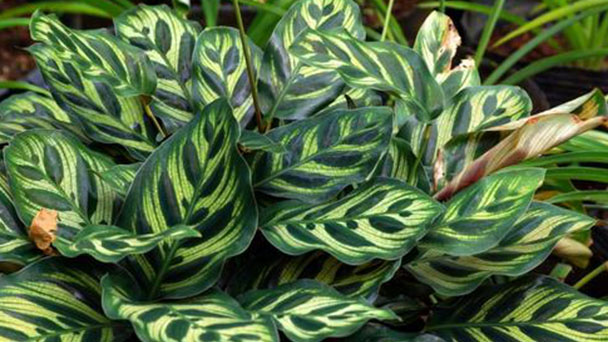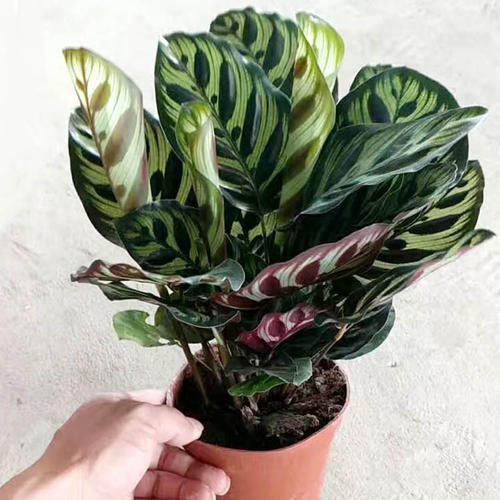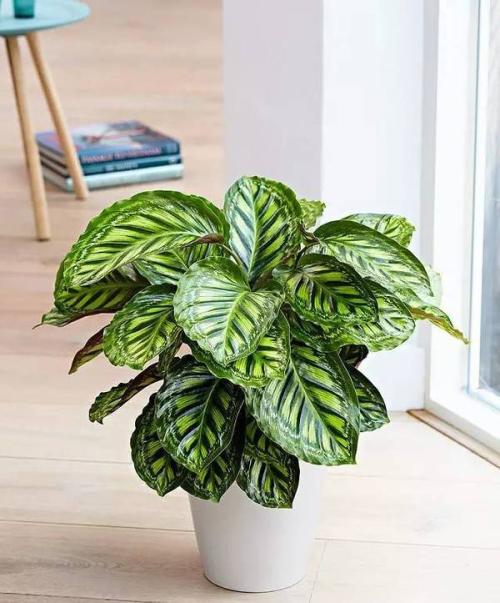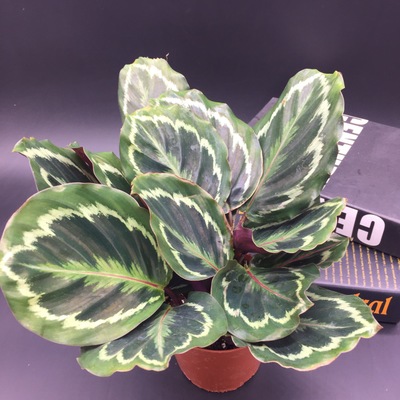Peacock plant profile
Written by Maggie
Jan 09 2021

Peacock plants with beautiful foliage, strong growth and shade tolerance makes it an ideal indoor green plant. can be appreciated as a single plant, or as a line of ground cover plants, to appreciate the beauty of the group, pay attention to provide a good background to set off. Use medium, small potted admire, main adornment decorates study, bedroom, sitting room to wait.
Peacock plants picture

Morphological characteristics of Peacock plants
Peacock plants are an evergreen perennial herb to 60 cm tall, rhizome, long and narrow spear-like leaves growing directly from roots, plant clumps. There are different shades of green stripes on the leaves, and the back of the leaves is mostly maroon. The leaves of this species are silver-green with dark green spots radiating from the midrib and a similar shaped maroon red spot on the back. Leaves are 30 ~ 60 cm high, 15 ~ 20 cm long and 5 ~ 10 cm wide, ovate-elliptic, thin, leathery, purple-red petiole. The green leaves are vaguely metallic and bright and gorgeous, with pinnate, dark green and long oval velvety plaques distributed along both sides of the midrib, which are arranged alternately on the left and the right. The leaf back is purplish red.
Habits and distribution of Peacock plants
Peacock plants are native to tropical America and islands of the Indian Ocean. In China Guangdong, Guangxi and other provinces have cultivation.
Peacock plants prefer semi-shade, not resistant to direct sunlight, suitable for growing in warm and humid environments. The planting season should be provided with a certain degree of shade, and the temperature should be maintained at about 12-29 ℃. In winter, the temperature should be maintained at 16-18 ℃. The spring and summer are flourishing, and high air humidity is needed, so spray can be carried out. The soil is not strictly required, but it should be kept moderately moist and fertilized about once every 2 weeks during the growing season, while the soil can be slightly dry and cool in winter, and the number of fertilization times can be reduced.

Peacock plants propagation methods
Peacock plants use plant division to propagate. Generally more than the late spring and early summer temperature of 20℃ or so combined with the basin for soil change. When the temperature is too low, the plant is easy to hurt the root, affecting the survival or growth weakness. The mother plant will be removed from the pot, the soil will be removed, with a sharp knife along the direction of underground rhizomes growth of the thick plants to cut, so that each cluster has 2-3 germination and robust roots. Immediately after cutting the pot fully watering, placed in a cool place, a week later gradually moving to the light is better, and we should control the water in the early stage.
The main value of Peacock plants
Garden use: the Peacock plant is half as effective at removing formaldehyde as other plants, but it puts it in a better position to eliminate ammonia pollution from the air (0.86mg of formaldehyde and 2.19mg of ammonia in 10 square metres). The plant is highly ornamental and also purifies the air.
2. Ornamental application: Peacock plant shape is neat, leaves rich wonderful delicate speckles, unique metallic luster, the brown patch is like a Peacock spreading screen, its color is fresh, luxuriant, soft, so it is more and more favored by people, becoming the treasure of indoor plants. It has strong adaptability and can be cultivated for a long time in the indoor environment with low light. Peacock plants often grow with small and medium-sized basins, and adornment cloth is placed in the place such as domestic study, bedroom, sitting room.

Latest Updated
- Benefits of Bugleweed - 7 Science-backed Health Benefits
- Bugleweed Dangers & Side Effects - Is It Poisonous?
- How to Plant Evergreen Trees - What You Should Know
- When to Plant Evergreens - Grow Guide for Evergreen Trees
- 12 Wonderful Evergreen Shrubs for Your Garden
- 12 Popular Evergreen Plants with Pictures for Beginners
- When And How To Prune A Lilac Bush Like a Pro
- How to Grow & Care for Lilac Vine (Hardenbergia Violacea)
- Japanese Lilac Tree (Syringa Reticulata) Care & Propagation Guide
- Shumard Oak Pros and Cons - What to Know
Popular Articles
- Winter maintenance of Antirrhinum Majus
- How to Grow Terminalia Mantaly Tree
- How to Grow and Care for Crossostephium Chinense
- How to grow Antirrhinum Majus in spring
- Peristeria Elata (Dove Orchid) Profile: Info & Care Guide
- Underwatered Snake Plant (Sansevieria Trifasciata) - Signs And How To Fix
- How to Care for Brazilian Jasmine Plant (Mandevilla Sanderi)
- How to Grow & Care for Graptopetalum Purple Delight in Summer
- Rosa Chinensis (China Rose): Plant Growing & Care Tips
- How to Care for Baby Sun Rose (Aptenia Cordifolia)